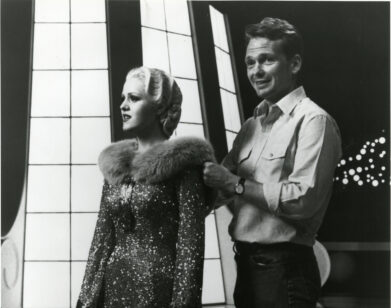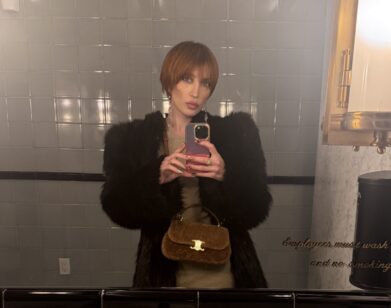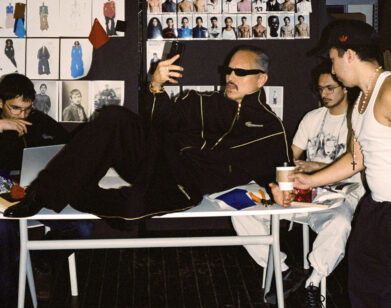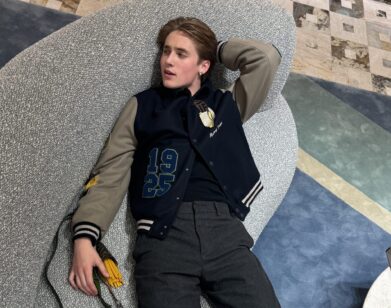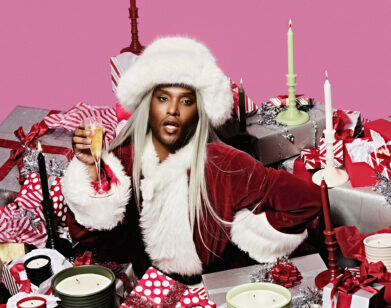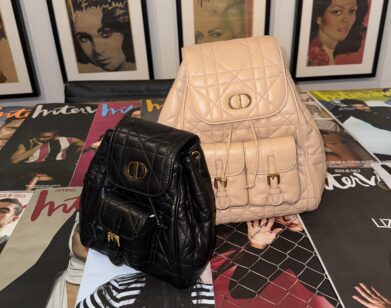DESIGNERS OF THE YEAR
Catherine Holstein and Willy Chavarria on Sexuality, Horror, and Honing Your Craft
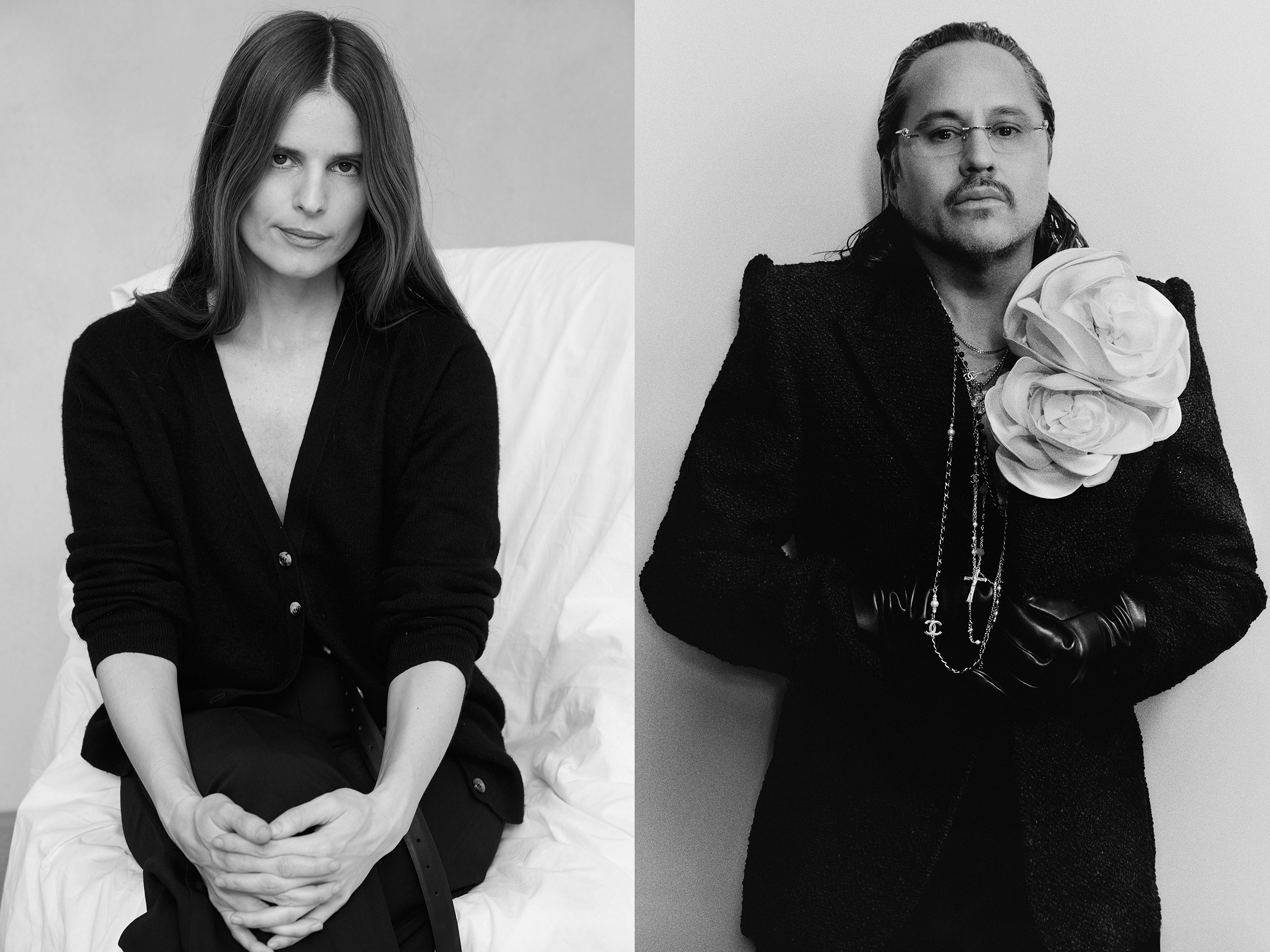
A week after securing her second CFDA award for American Womenswear Designer of the year, Catherine Holstein of Khaite called up her counterpart Willy Chavarria, the 2023 CFDA American Menswear Designer of the year, to discuss martinis, work-life balance, and waking people up with fashion in an era that feels less subversive than ever before.
———
WILLY CHAVARRIA: Hi Cate.
CATHERINE HOLSTEIN: Hi! So funny, Willy and I met in person the other night at this hotel I’m staying at because my renovation is never going to be done ever, and it’s right down the street from his house. I think it was the night after the CFDAs.
CHAVARRIA: It was. That’s my secret hangout spot. It’s the best hotel in the world. And they have amazing martinis.
HOLSTEIN: They do. I’m a martini person, so it’s always very important that they’re very cold and don’t have too much vermouth.
CHAVARRIA: I like the vermouth to just tap the glass.
HOLSTEIN: Yeah, just a rinse.
CHAVARRIA: So how has life changed for you since you took away the CFDA award for best women’s fashion designer?
HOLSTEIN: Winning for the second time has been a real shock to the system. I’ve been doing this for 20 years, and I felt really up against the world. Starting a luxury line is the dream and I think it’s really hard to be taken seriously, especially as a woman, so I feel really honored and touched and proud. I want to show my son what a strong woman is and I feel really grateful to have that opportunity. How about you?
CHAVARRIA: That’s amazing. Honestly, it’s been nonstop since I started this brand. I don’t want to do anything that doesn’t move the needle in some way, so I take my shit so seriously. I’m just so involved in it that when an award pops up, it’s like, “Okay, wow.” It really took my breath away.
HOLSTEIN: Same.
CHAVARRIA: I’m doing it with as much love and passion and heart as I possibly can. If anything, since the awards, there’s just been more demand press-wise and custom-wise. Do you do custom?
HOLSTEIN: We try to, but we’ve been so busy. We do so many collections so we can only accommodate very little custom right now and we are really discerning with what we take on. It’s usually for something like the Met Gala or a major premiere.
CHAVARRIA: I hear you. I think it is nice in the beginning because you get to see your stuff on the red carpet, you get great exposure. From a press standpoint, it’s really good, but it is so time-consuming. Every person that you work with has completely different needs. When I was at Calvin, it’s like we had to put together a team to just address that.
HOLSTEIN: Yeah.
CHAVARRIA: I don’t currently have that luxury in my current business, it’s just me, but I do enjoy it. I just don’t have a lot of bandwidth.
HOLSTEIN: We’re getting bigger, but we still don’t even have the bandwidth. I almost think men need it more.
CHAVARRIA: It’s funny because most of the custom I do is for women. My clothes have always been much more fit-oriented than sexuality-oriented.
HOLSTEIN: I shop a lot of men’s, so I get it.
CHAVARRIA: And I shop a lot of women’s.
HOLSTEIN: Do you think you’d ever show women’s?
CHAVARRIA: I don’t think I would because what I show now is for men and women to wear. I have just as many female models or female-presenting models in my shows as I do male models or male-presenting models. So it’s just like when I design the clothes—do you sketch?
HOLSTEIN: I do sketch, but hardly anymore. I stopped sketching probably three years ago.
CHAVARRIA: This is a really bad one, but my sketches look like that.
HOLSTEIN: That’s so cute though.
SPEAKER 1: Can you describe it a little bit just for the readers?
CHAVARRIA: Okay. It is a circular face with two round dots as eyes and a line across the mouth, which is expressive of both male, female, and gender-nonconforming humans. And then the body is just a stick. So I kind of design around that, and then when it comes time to assemble a collection for a presentation or a runway show, it’s just like, “Okay, who’s going to look best in this look?”
HOLSTEIN: Yeah. I’m such a product junkie, so we design by product and then we assemble the looks and styling.
CHAVARRIA: I’m very much the same, but if I’m working for a big company, we will define the concept and 700 people will sign off on it, and then 600 people will be paid to make sure that concept follows through to the delivery. But I think we have the privilege that we can just let it evolve and become what is most needed at the very end. So I’ll start out with one thing and then three months later I’m listening to a totally different kind of music and the politics in the world are different. It’s like the collection evolves with me.
HOLSTEIN: Exactly. It’s a natural human process.
CHAVARRIA: I love that part.
HOLSTEIN: It’s the best. I’m just so lucky that I have the opportunity to even come to this job every day. The opportunity to design. It’s a drug for me. I’m addicted to it.
CHAVARRIA: Yeah. I can’t do anything else.
HOLSTEIN: Same. Unfortunately, I made life hard on myself, decided to go into this industry, but it was a long road, but it’s been an amazing transformation and I feel like I’ve been really lucky, like, grace of god lucky.
CHAVARRIA: I feel the same. I’m a big god person and I pray all the time and I’m giving thanks constantly. The world is totally for shit right now, and we are very fortunate that we’re able to navigate our days of stress through fabrics and deliveries.
HOLSTEIN: Exactly. My parents unfortunately passed, my mom fairly recently, and I’ve been having such incredible luck actually since her passing in many wild ways throughout my personal life and through work. That’s why at the end of my speech I thank my mom and dad up there because I really believe they’re watching over me.
CHAVARRIA: I believe it too. This business is quite grueling. It’s not for the faint of heart by any means. I think you have to have some kind of faith.
HOLSTEIN: You have to. Because that faith makes you believe in yourself. When I was forming this company, I was up against a lot. I wanted to start an American luxury brand. People were like, “You’re crazy. America doesn’t do luxury.” I’m still up against that. But I’ve always just been like, “You’ve got to just power through, and you can’t even think about this going badly. You don’t have a choice.” I’m amazed what a person can accomplish if they have faith in themselves.
CHAVARRIA: One hundred percent. So what about sexuality? How do you put that into your work?
HOLSTEIN: I’m really attracted to sensuality and sexuality and being provocative. I like to push boundaries. Our shows are usually quite dark, they’re very moody. I find that to be incredibly sexy and seductive. How about you?
CHAVARRIA: To be honest, I’m a little tired of sexy, and it might be my age, but I feel like in the ’90s when we saw a man in his underwear on the side of a building for the first time, sex was so hot. But I think sensuality is much more valuable in today’s day and age. We see sex everywhere, we can’t pick up the phone without seeing some sex thing.
HOLSTEIN: True, true.
CHAVARRIA: I love sex. I’m a big fan of sex. I have it all the time.
HOLSTEIN: [Laughs]
CHAVARRIA: But I think it’s just more interesting from an artistic perspective to hone in on the sensuality that we all own.
HOLSTEIN: Yeah. I’m really still attracted to Christiane F. seediness. That’s why I came to New York in the first place, for the seduction of the ’80s and ’90s. I grew up in London and I moved here in 2002, but I was so mesmerized by it from a very young age. I think the rawness that New York really hones in on needs to come back. I think the sexiness that’s in advertising now isn’t—there’s nothing offensive about it anymore. It was so amazing when Tom Ford was at Gucci and he did those things that nobody had ever seen before. Today, people are too scared to really go there, especially some of the bigger brands that have more to lose. For lack of a better photographer, the Terry Richardson effect, that was so new back then, and I’m kind of missing that aesthetic. Again, Christiane F. is always one of my favorites, as far as darker movies go.
CHAVARRIA: I love that movie, but my favorite movie is The Exorcist.
HOLSTEIN: Oh, I love that. I love horror.
CHAVARRIA: You do?
HOLSTEIN: It’s my favorite genre.
CHAVARRIA: Me too. The Exorcist to me is so gorgeous. That color palette, everything Chris MacNeil [played by Ellen Burstyn] wears. The hospital scenes with that gorgeous blue and Linda’s blood spurting all over it.
HOLSTEIN: It’s very vivid.
CHAVARRIA: But what you were saying about risk taking, it almost seems like we’re at a stage right now in American fashion where everything is very safe. You don’t see the larger brands taking any risk at all. Whereas people like us, who are not yet mega global brands, still have the ability to move the needle forward and wake people up. Anytime I think of super hot, high-sexed marketing, it’s definitely from the past or smaller designers like Victor Barragán posting nudes of himself with a hard on.
HOLSTEIN: [Laughs]
CHAVARRIA: Congratulations on your store, by the way.
HOLSTEIN: Thank you. My husband’s an architect, so he designed it. We’re opening multiple stores both domestically and globally and he’s in charge of all of it. I don’t think I’ll ever meet a more talented architect than him, so I just feel incredibly lucky to have him working on the brand.
CHAVARRIA: Yeah, I feel the same [about my husband]. I was like, “Can you just have a look at my brand and tell me if I’m doing it right?” And he came in and he was like, “You got to do this. You need to do this, you need to do this.” And I was just in awe of his intelligence, and I love that he is able to disconnect from the creative part that I’m so heavily involved in.
HOLSTEIN: I hear you. We just brought on a CEO and before that I was the CEO and creative director, and it was a real challenge for me, so I’m really excited now to be back in the thick of all the creative. We brought in a woman named Brigitte Kleine, who’s such a genius in the industry. She was the CEO of Tory Burch from inception until they sold, and before that she was the CEO of Alexander McQueen. I’m like, “I finally got my life back.” I can go home at the end of the day and be with my son and not be worried about the P&L, which was my existence before. It was just so stressful.
CHAVARRIA: I still need to have oversight of every single thing that’s going on, but I love working with other people. It’s a communal effort. But I do need to see every single detail. It’ll probably never end.
HOLSTEIN: No, I don’t think it ever ends for anybody, no matter how big you get. In fact, you need to be more involved the bigger you get because otherwise you can get really out of control.
CHAVARRIA: But I do not want to be Suzy Menkes wobbling into a party at 3:00 AM because I have to write about it or be there. I just want to get to a point in my life where I am separated from the hype and the overt fashion of it all.
HOLSTEIN: Yeah. I think having my son did that for me. That’s when I realized what life really was about and I’m really happy about that. Before it was all work.
CHAVARRIA: Definitely. I realized at some point in the last few years that the idea of a work-life balance doesn’t exist, so you have to make it right for you. We have to love the work we do so that we’re actually fueled by the energy that we put out. Or else it’s just going to take away from you and you’re not going to be happy. As long as what we’re doing is still fueling our fire and keeping us excited and passionate about life, then more power to it.
HOLSTEIN: Absolutely.

